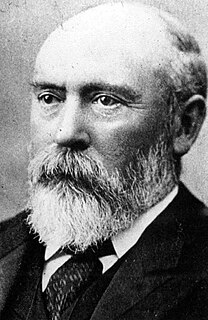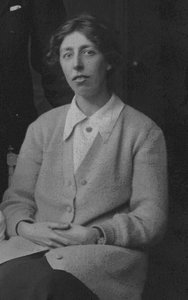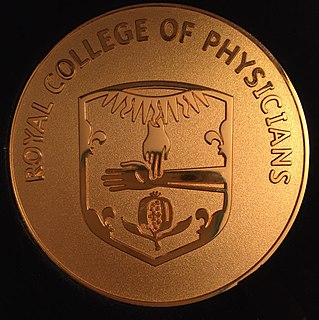Related Research Articles

Sir Frederick Gowland Hopkins was an English biochemist who was awarded the Nobel Prize in Physiology or Medicine in 1929, with Christiaan Eijkman, for the discovery of vitamins, even though Casimir Funk, a Polish biochemist, is widely credited with discovering vitamins. He also discovered the amino acid tryptophan, in 1901. He was President of the Royal Society from 1930 to 1935.
The Slade Professorship of Fine Art is the oldest professorship of art and art history at the universities of Cambridge, Oxford and University College, London.
Juda Hirsch Quastel, was a British-Canadian biochemist who pioneered diverse research in neurochemistry, soil metabolism, cellular metabolism, and cancer.
Norman Wingate (Bill) Pirie FRS, was a British biochemist and virologist who, along with Frederick Bawden, discovered that a virus can be crystallized by isolating tomato bushy stunt virus in 1936. This was an important milestone in understanding DNA and RNA.

Sir Hans Leo Kornberg, FRS was a British-American biochemist. He was Sir William Dunn Professor of Biochemistry in the University of Cambridge from 1975 to 1995, and Master of Christ's College, Cambridge from 1982 to 1995.

Sir William Bate Hardy, FRS was a British biologist and food scientist. The William Bate Hardy Prize is named in his honour.

The MRC Mitochondrial Biology Unit is a department of the School of Clinical Medicine at the University of Cambridge, funded through a strategic partnership between the Medical Research Council and the University. It is located at the Addenbrooke’s Hospital / Cambridge Biomedical Campus site in Cambridge, England. The unit is concerned with the study of the mitochondrion, as this organelle has a varied and critical role in many aspects of eukaryotic metabolism and is implicated in many metabolic, degenerative, and age-related human diseases.
William, Willie or Billy Dunn may refer to:
Ernest Hubert Francis Baldwin was an English biochemist, textbook author and pioneer in the field of comparative biochemistry.

Dorothy Mary Moyle Needham FRS was an English biochemist known for her work on the biochemistry of muscle. She was married to biochemist Joseph Needham.
Quain Professor is the professorship title for certain disciplines at University College London, England.
The Sir William Dunn Institute of Biochemistry at Cambridge University was a research institute endowed from the estate of Sir William Dunn, which was the origin of the Cambridge Department of Biochemistry. Created for Frederick Gowland Hopkins on the recommendation of Walter Morley Fletcher, it opened in 1924 and spurred the growth of Hopkins's school of biochemistry. Hopkins's school dominated the discipline of biochemistry from the 1920s through the interwar years and was the source of many leaders of the next generation of biochemists, and the Dunn bequest inaugurated a period of rapid expansion for biochemistry.

Sir William Dunn, 1st Baronet,, was a London banker, merchant and philanthropist, Liberal Member of Parliament for Paisley (1891–1906), and from before 1896 until the outbreak of the Second Boer War in 1899 consul general for the Orange Free State in the United Kingdom.

Muriel Wheldale Onslow was a British biochemist, born in Birmingham, England. She studied the inheritance of flower colour in the common snapdragon Antirrhinum and the biochemistry of anthocyanin pigment molecules. She attended the King Edward VI High School in Birmingham and then matriculated at Newnham College, Cambridge in 1900. At Cambridge she majored in botany. Onslow later worked within Bateson's genetic group and then Frederick Gowland Hopkins biochemical group in Cambridge, providing her with expertise in biochemical genetics for investigating the inheritance and biosynthesis of petal colour in Antirrhinum. She was one of the first women appointed as a lecturer at Cambridge, after moving to the Biochemistry department.
The Anatomical Society (AS), previously known as the Anatomical Society of Great Britain and Ireland or ASGBI was founded in London in 1887 to "promote, develop and advance research and education in all aspects of anatomical science".

Antoinette (Tony) Pirie was a British biochemist, ophthalmologist, and educator.
The Hopkins-Cole reaction, also known as the glyoxylic acid reaction, is a chemical test used for detecting the presence of tryptophan in proteins. A protein solution is mixed with Hopkins Cole reagent, which consists of glyoxylic acid. Concentrated sulfuric acid is slowly added to form two layers. A purple ring appears between the two layers if the test is positive for tryptophan. Nitrites, chlorates, nitrates and excess chlorides prevent the reaction from occurring.

The Baly Medal is a biennial award awarded by the Royal College of Physicians of London.

Barnet Woolf FRSE was a 20th-century British scientist, whose disciplines had a broad scope. He made lasting contributions to biochemistry, genetics, epidemiology, nutrition, public health, statistics, and computer science. His name appears in the Hanes-Woolf plot: a mathematical plotting of chemical reaction times.
References
- 1 2 "Professors". Cambridge. Retrieved 10 April 2019.